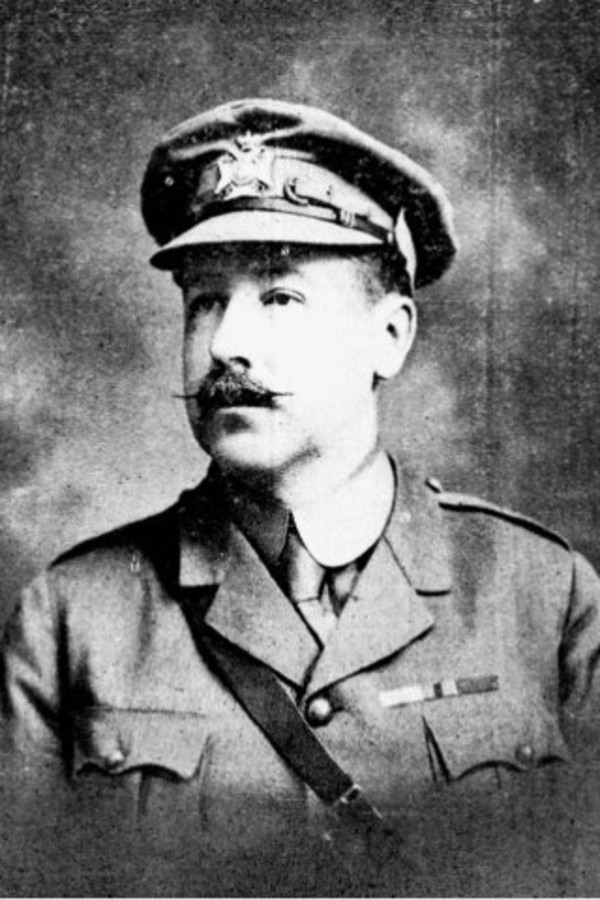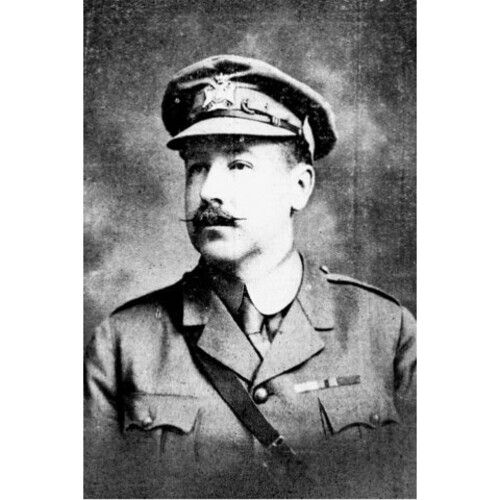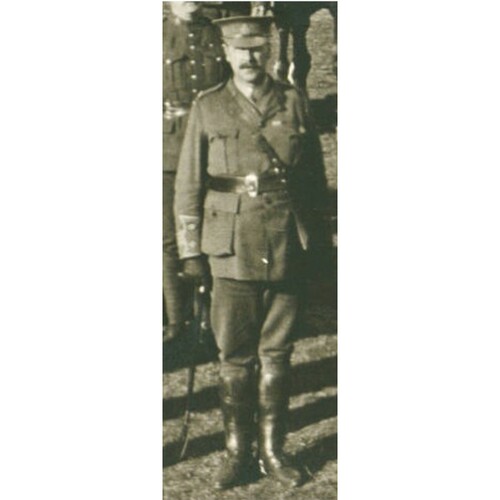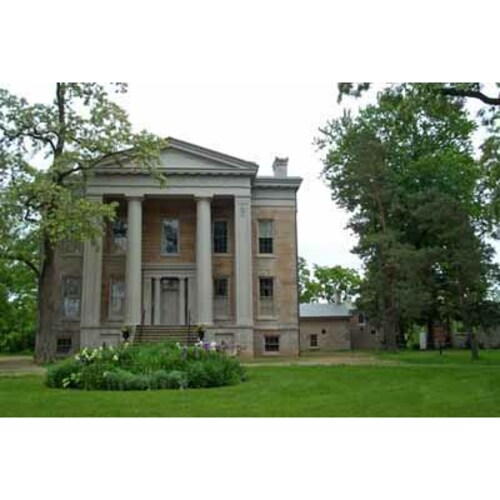
Source: Link
THOMPSON, ANDREW THORBURN, lawyer, militia and army officer, politician, editor, businessman, and author; b. 27 May 1870 in Ruthven Park, near Cayuga, Ont., fifth of the six children of David Thompson, mp, and Elizabeth Stinson; m. first 19 Oct. 1893 Violet Isabel Burns (d. 15 Dec. 1926) in Toronto, and they had two sons, one of whom predeceased his father, and one daughter; m. there secondly 2 June 1930 Ann Maud Bell, née Smith (d. 12 March 1966); they had no children; d. 20 April 1939 in Ottawa.
On the night of Andrew Thorburn Thompson’s birth in May 1870, his father, David, was on duty with the 37th (Haldimand) Battalion of Infantry as it prepared for an anticipated Fenian raid on the shores of Lake Erie. Expecting at any moment to receive a message that the raid had begun, David learned instead of the birth of his son. As a youngster Andrew showed both talent and scholarly interests, and at age 20 he graduated at the top of his class with a ba from the University of Toronto. In 1891 he obtained his llb. While an undergraduate, he had enlisted in K Company, the university detachment of the 2nd Battalion of Rifles (Queen’s Own Rifles of Canada), and rose to the rank of colour sergeant. Andy, as he was known to friends, had also been active in the university’s glee club and as a writer and actor in its literary society. In 1893 he graduated from Osgoode Hall law school and was called to the bar. He married Toronto socialite Violet Burns that year and began to practise in Cayuga.
Thompson had joined the 37th Battalion in 1892; he rose to the rank of major and represented the regiment at Queen Victoria’s diamond jubilee celebrations in London in 1897. Promoted lieutenant-colonel, he commanded the unit from 1901 to 1909. When his supporters chose him as Liberal mp for the riding of Haldimand and Monck in the general election of November 1900, they may have believed that he had been born to the role. His father and his paternal grandfather, also named David Thompson, had both represented the region. His grandfather had been forced to fight his way out of the burning parliament buildings during the Montreal riot of 1849 [see James Bruce*]. The elder David had been lieutenant-colonel, and his son senior major, in the Haldimand militia, and they carried on the family’s lumber, farming, and mercantile business at their 1,500-acre estate, Ruthven Park, now a national historic site. Andrew Thompson continued the family business and eventually owned 2,500 acres in Seneca and Oneida townships, including rental farms. He held mortgages for properties in the Cayuga area and invested in land near Winnipeg and Yorkton (Sask.).
After Thompson was appointed Liberal Party whip in 1901, the Canadian Military Gazette (Montreal) paid tribute to this new member of Sir Wilfrid Laurier*’s government, welcoming him to the ranks of the prominent “parliamentary colonels” in Ottawa. Thompson was chosen as second in command to Henry Mill Pellatt in the Canadian contingent that was to attend the coronation of Edward VII in 1902. In London he took part in festive events and met with many of Great Britain’s most important military and political leaders. In the federal election of 3 Nov. 1904 he was narrowly edged out of his riding, which had been renamed Haldimand, by the Conservative candidate, Francis Ramsay Lalor.
Ruthven Park remained the family’s country estate, but in 1905 Thompson, deciding that his legal and political career would be best served in Ottawa, moved his young family and his law practice to the nation’s capital. There he specialized in counsel on parliamentary matters. He would be named a kc in 1921. Thompson began to invest heavily, mainly in bonds and mining stocks, on the advice of his friend Pellatt. He also held shares in Brazilian Traction, Light and Power, and he acted as an Ottawa agent for the Canadian Pacific Railway, British Columbia Electric Railway Company Limited, Ontario Power Company, Canadian Manufacturers’ Association, and other organizations.
In 1906 Thompson and a group of investors purchased the Canadian Military Gazette and he became its editor. Despite his ties to the Liberal Party, he vowed that the paper would stay politically neutral and, in his words, “devoted to the interests of the military forces of Canada.” He remained editor for the rest of his life and was succeeded by his son, Major Andrew Ruthven Thompson.
A prominent advocate of the militia, Thompson considered a strong, efficient voluntary force of citizen-soldiers to be Canada’s “national life insurance.” In 1908 he was appointed deputy assistant adjutant general for the celebration of the tercentenary of Quebec City [see Albert Henry George Grey*]. Promoted to command the 5th Infantry Brigade in Niagara in 1909, he dedicated himself to training what he hoped might someday become “the finest citizen soldiery the world has yet produced.” He held the post until 1913 and then joined the reserve of officers. When the First World War broke out, most men of the 37th Regiment (Haldimand Rifles) enlisted in the 114th Infantry Battalion of the Canadian Expeditionary Force. Like the regiment, the 114th drew almost half of its strength from the Six Nations Reserve, on the border of Haldimand County, as well as from reserves in eastern Ontario. Thompson had been made an honorary chieftain of the Six Nations, probably in 1909, and was given the name Ahsaregoah, meaning “the sword.” When the battalion’s colonel, his long-time friend Edwy Sutherland Baxter, died of typhoid in February 1916, Thompson was asked to take command. At his request, the battalion became known as Brock’s Rangers in honour of Sir Isaac Brock*. Members of the Six Nations and settlers of the Haldimand and Niagara regions, including Thompson’s grandfather, had fought alongside Brock at Queenston Heights during the War of 1812. When the 114th Battalion proceeded overseas in November, among its officers were Thompson’s two sons, Andrew Ruthven and Walter Hepburn.
On arriving in England, Lieutenant-Colonel Thompson was severely disappointed to learn that the 114th was to be broken up to reinforce battalions already at the front. Concerned because he would not lead his men into battle, he was even more distressed that he would not be able to honour the commitment he had made to the mothers of Haldimand County soldiers to watch out for their sons. Instead, he was placed in command of the 2nd Central Ontario Regimental Depot. His faith in the Canadian militia was tested when he realized that officers like himself, although esteemed in their communities, were considered surplus by Canadian military officials in England, and that they would be criticized by those at home for not having accompanied their men into battle. He wrote about the situation in the Canadian Military Gazette. During the conflict he suffered from renal calculus, and both his sons were seriously wounded. While hospitalized, he wrote poetry to help him endure his emotional turmoil. He returned to Canada in 1918.
Thompson’s support of Indigenous soldiers as commanding officer of the 114th Battalion and later as a veterans’ advocate, and in his position as editor of the Canadian Military Gazette, centred on trying to enable them to retain the federal electoral franchise that Indigenous people serving in the armed forces had earned in 1917. Once demobilized, they were required to relinquish their Indian status and other rights if they wanted to vote. Thompson’s advocacy led to his appointment in 1923 to the one-man royal commission to investigate and enquire into the affairs of the Six Nations Indians. After extensive research into and interviews about the political, educational, and social situation on the reserve, he recommended the replacement of the hereditary chieftain’s council [see Deskaheh*] with a modern elective system. His task had been delicate since the division between the opposing factions of the Six Nations was deep and bitter [see Frederick Ogilvie Loft]. His findings were adopted by the Department of Indian Affairs and implemented in 1924.
Throughout the post-war period Thompson remained closely associated with the Liberal Party. He and Prime Minister William Lyon Mackenzie King* would be friends for over 40 years, the latter passing many weekends at Ruthven Park. Thompson accompanied King on his cross-Canada election campaign of 1926, and his wife, Violet, bedridden with an illness that would lead to her death a few months later, was the first person to whom King sent a telegram announcing his electoral victory. The post-war period was marked by other family tragedies. Thompson’s elder son, Andrew, who became gentleman usher of the Black Rod in the Senate in 1925, continued to suffer from injuries sustained in battle. Walter sought medical treatment for depression, but he never recovered from his wartime trauma and committed suicide in 1929.
During his lifetime Thompson wrote over 100 poems; they were religious or sombre during the war but became lighter in tone and quite humorous as the years went by. Some were published in the Toronto magazines Maclean’s and Saturday Night, and others appeared frequently in the Canadian Military Gazette. A comedy, The Canadian knights entertainment, a poetic satire on the many political occupations in Ottawa, appeared in 1919, and he compiled a book of 135 humorous or reflective sketches of Cayuga characters and many stories for publication, but abandoned the project owing to illness. Thompson was a regular speaker at significant militia events, the Canadian Military Institute, and Canadian clubs in various cities. In Ottawa he was considered a respected and influential counsel, a tireless spokesman for the militia, and an astute investor. He died of septicaemia in 1939, but not before publishing a series of editorials in the Canadian Military Gazette in which he voiced his fears that yet another devastating war was on the horizon. Following a career reflecting level-headedness, impartiality, integrity, and efficiency, he was remembered for his energetic devotion to the country, his creativity, and his wonderful sense of humour, which was mentioned in numerous messages of condolence sent to his family.
Andrew Thornburn Thompson is the author of The Canadian knights entertainment (n.p., 1919); Report by Col. Andrew T. Thompson, b.a., ll.b., commissioner to investigate and enquire into the affairs of the Six Nations Indians, 1923 (Ottawa, 1924); and The odyssey of the gentlemen adventurers travelling into the Brazils: W. Miller Lash, A. W. K. Billings, J. W. McConnell, C. H. N. Ashlin, James McKean, Andrew T. Thompson (Ottawa, 1928).
LAC, RG10, vol.7504, file 25,032-1-2, pt.1 (Six Nations Agency – disputes between Six Nations Indians and the government of Canada); vol.7931, file 32-32, pt.3 (Six Nations Agency – elections of chiefs and councillors on the Six Nations reserve), December 1924–October 1926; RG24-C-8, vol.4380, file MD2-34-7-89, pt.1 (WW I organization – 114th Battalion, Haldimand County), 1916; vol.4383, file MD2-34-7-109 (enlistment of Indians in CEF), corr., Lt.-Col. A. T. Thompson and Col. Sidney Mewburn, 1 March and 13, 20, 26 April 1916; RG150, Acc. 1992–93/166, box 9622-32. Ruthven Park National Site (Cayuga, Ont.), Thompson papers. UTARMS, A1973-0026/466(83). Ottawa Evening Journal, 21 April 1939. Canadian Military Gazette (Montreal), 1906–39. D. C. Scott, “The Canadian Indians and the Great World War,” in Canada in the Great World War: an authentic account of the military history of Canada from the earliest days to the close of the war of the nations (6v., Toronto, 1917–21), 3: 285–328. T. C. Winegard, For king and Kanata: Canadian Indians and the First World War (Winnipeg, 2012). J. [A.] Wood, Militia myths: ideas of the Canadian citizen soldier, 1896–1921 (Vancouver and Toronto, 2010).
Cite This Article
James Wood, “THOMPSON, ANDREW THORBURN,” in Dictionary of Canadian Biography, vol. 16, University of Toronto/Université Laval, 2003–, accessed December 17, 2025, https://www.biographi.ca/en/bio/thompson_andrew_thorburn_16E.html.
The citation above shows the format for footnotes and endnotes according to the Chicago manual of style (16th edition). Information to be used in other citation formats:
| Permalink: | https://www.biographi.ca/en/bio/thompson_andrew_thorburn_16E.html |
| Author of Article: | James Wood |
| Title of Article: | THOMPSON, ANDREW THORBURN |
| Publication Name: | Dictionary of Canadian Biography, vol. 16 |
| Publisher: | University of Toronto/Université Laval |
| Year of publication: | 2023 |
| Year of revision: | 2023 |
| Access Date: | December 17, 2025 |





